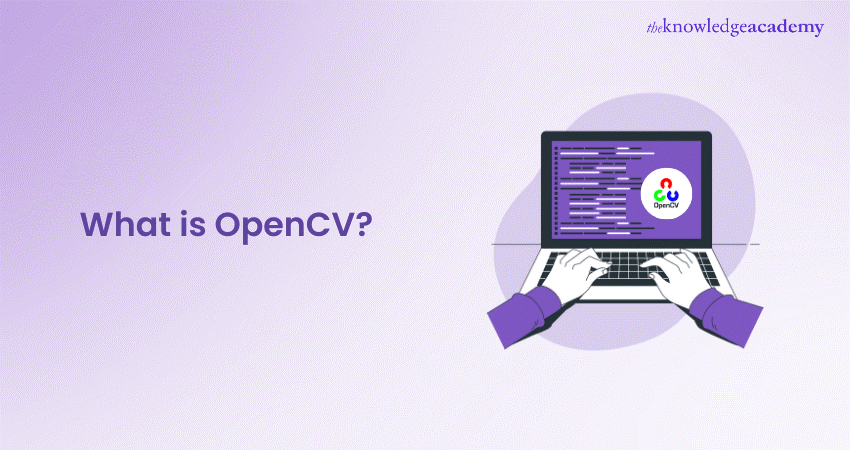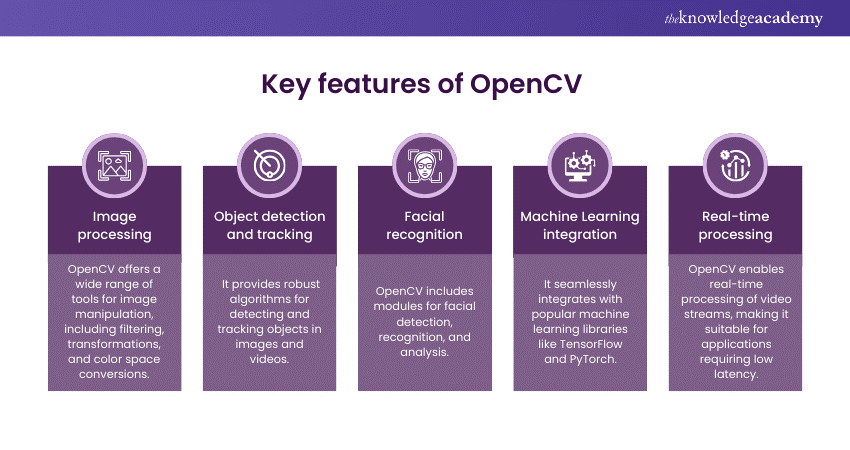We may not have the course you’re looking for. If you enquire or give us a call on +971 8000311193 and speak to our training experts, we may still be able to help with your training requirements.
Training Outcomes Within Your Budget!
We ensure quality, budget-alignment, and timely delivery by our expert instructors.

What is OpenCV? Often heard but not always understood, OpenCV stands for Open-Source Computer Vision. It is a robust library of programming functions designed to tackle various Computer Vision tasks. From real-time object detection to facial recognition, OpenCV is the go-to tool for developers and researchers. But what exactly is OpenCV, and how does it work?
In this blog, we will delve into the world of Computer Vision and explore the intricacies of OpenCV. We will answer the question, 'What is OpenCV?' by examining its core features, capabilities, and applications. Let’s dive in to learn more!
Table of Contents
1) What is OpenCV?
2) History of OpenCV
3) Key Features of OpenCV
4) OpenCV's Vision Capabilities
5) Challenges and future direction of OpenCV
6) Conclusion
Understanding What is OpenCV
OpenCV, or Open-Source Computer Vision Library, is an open-source Computer Vision and Machine Learning software library. It offers various real-time image and video processing functionalities, including object detection, facial recognition, motion tracking, and Augmented Reality (AR).
OpenCV is widely used in various domains such as robotics, medical imaging, surveillance, and autonomous vehicles. It offers several tools and algorithms and support for various programming languages like Python, C++, and Java. This makes it accessible to developers worldwide for building advanced Computer Vision applications and solutions.
History of OpenCV
OpenCV is one of the most popular and widely used Computer Vision and Machine Learning software libraries. The origins of OpenCV can be traced back to the late 1990s when Intel launched a research project to develop high-performance applications for real-time vision. The project became an open-source initiative in 2000. The goal was to provide a common infrastructure and resources for researchers and developers in Computer Vision and Machine Learning. Since then, OpenCV has grown exponentially thanks to the efforts of a large and diverse community of contributors worldwide.
OpenCV offers more than 2500 algorithms for various vision tasks, such as image processing, feature extraction, face detection, object recognition, image stitching, video analysis, and 3D reconstruction. It supports several programming languages and platforms, making it accessible and adaptable to different needs and preferences. OpenCV has been applied to many domains, such as autonomous driving, robotics, Augmented Reality, security, and entertainment. OpenCV continues to be at the forefront of Computer Vision and Machine Learning innovation, and it is regularly evolving to meet the challenges and opportunities of the future.
Key features of OpenCV

OpenCV boasts a rich set of key features, making it a versatile and powerful tool for various Computer Vision tasks. One of its primary features is its extensive collection of pre-built algorithms for image and video processing, including functions for filtering, edge detection, feature extraction, and more. These algorithms enable developers to perform various operations on images and videos efficiently, such as enhancing quality, detecting objects, and tracking motion.
Another critical feature of OpenCV is its support for multiple programming languages, including Python, C++, and Java. This multi-language support makes OpenCV accessible to a diverse community of developers, allowing them to leverage their preferred programming language to work with visual data. Additionally, OpenCV offers cross-platform compatibility, enabling developers to seamlessly deploy their applications on different operating systems and hardware architectures.
Furthermore, OpenCV provides built-in support for Deep Learning frameworks like TensorFlow and PyTorch, allowing developers to integrate state-of-the-art Machine Learning models into their Computer Vision applications. This integration opens up many possibilities for advanced tasks and let's explore some of them below:
1) Object detection
2) Image classification
3) Semantic segmentation
Unlock new opportunities in the field of Computer Vision and Artificial Intelligence with our expert-led Face Recognition Training!
OpenCV's vision capabilities
OpenCV’s versatility spans a wide array of tasks within Computer Vision.
1) Rapid object detection in real-time
A prominent feature of OpenCV lies in its real-time object detection capabilities, employing image recognition to pinpoint specific objects within images or video streams. This functionality finds utility across diverse domains, including autonomous vehicles and industrial manufacturing, where it facilitates identifying and tracking entities like cars, humans, animals, or specific components.
2) Precision image segmentation
OpenCV excels in image segmentation, employing sophisticated algorithms to partition images into distinct segments, thereby simplifying or enhancing them. This functionality is invaluable in autonomous driving, aiding road detection and delineation.
3) Recognition of movement and gestures
OpenCV offers robust movement and gesture recognition capabilities, enabling the interpretation and comprehension of human gestures via video analysis. This feature facilitates recognising and categorising body, hand, or facial movements, often applied in pose estimation to analyse body kinetics concerning key anatomical points.
4) Advanced face recognition
Facial recognition is another forte of OpenCV, boasting a suite of Face Recogniser algorithms proficient in detecting human faces and matching them against databases based on identified facial features.
5) Integration for Augmented Reality
OpenCV supports Augmented Reality (AR), fostering real-time interactions between the physical and virtual realms. AR tries to enhance our perception of the physical world by overlaying computer-generated perceptual data, thereby unlocking many possibilities for immersive experiences.
Stay ahead in the rapidly evolving fields of AI and biometrics with our Face and Speech Recognition Courses!
Challenges and future direction of OpenCV
OpenCV, a potent tool in Computer Vision, continually evolves to address various challenges and align with future trends. One such challenge is the intricacy of real-world situations where elements like lighting conditions, occlusions, and object appearance variations can hinder accurate detection and recognition. Developing sophisticated algorithms and sturdy models to manage such variability is crucial to overcome these challenges.
The necessity for enhanced performance and efficiency is another challenge, particularly in real-time applications such as autonomous driving and robotics. OpenCV must persistently optimise its algorithms and employ hardware acceleration techniques to achieve quicker processing speeds and reduce resource requirements.
Moreover, OpenCV must stay up to date with the emerging technologies and trends in Computer Vision, like Deep Learning and Neural Networks. Integrating these advanced techniques into the library necessitates continuous research and development to ensure developers find it compatible, efficient, and user-friendly.
OpenCV must also address privacy and security concerns, especially in facial recognition applications and biometric data. Implementing robust encryption and privacy-preserving techniques is vital to protect sensitive information and prevent misuse.
Overall, OpenCV’s future directions include improving support for edge computing and IoT devices, enabling intelligent vision processing at the edge. This involves algorithm optimisation for low-power, resource-constrained environments and seamless integration with edge computing frameworks.
Furthermore, OpenCV is expected to advance in several areas as the demand for immersive user experiences grows across various domains. This includes mixed reality, Virtual Reality, and Augmented Reality. Integrating AR/VR platforms and tools will be pivotal for OpenCV to realise its potential in these applications fully.
Conclusion
In conclusion, OpenCV is an invaluable tool for Computer Vision applications, offering many features and capabilities. Despite facing challenges, its versatility and extensive library of functions make it a vital asset for developers in various fields. Understanding What is OpenCV is essential for harnessing its full potential in future innovations.
Unlock the power of Computer Vision with our OpenCV with Python Training and turn your ideas into intelligent applications!
Frequently Asked Questions

Beginners can use OpenCV, but it requires some programming knowledge, particularly in languages like Python or C++. However, many resources and tutorials are available to help newcomers get started.

Yes, OpenCV is capable of real-time processing and analysis of images and video streams. It provides efficient algorithms and tools that enable developers to build applications for tasks like object detection, face recognition, and Augmented Reality in real-time environments.

The Knowledge Academy takes global learning to new heights, offering over 30,000 online courses across 490+ locations in 220 countries. This expansive reach ensures accessibility and convenience for learners worldwide.
Alongside our diverse Online Course Catalogue, encompassing 17 major categories, we go the extra mile by providing a plethora of free educational Online Resources like News updates, Blogs, videos, webinars, and interview questions. Tailoring learning experiences further, professionals can maximise value with customisable Course Bundles of TKA.

The Knowledge Academy’s Knowledge Pass, a prepaid voucher, adds another layer of flexibility, allowing course bookings over a 12-month period. Join us on a journey where education knows no bounds.

The Knowledge Academy offers various Face and Speech Recognition Courses, including CMUSphinx Training and OpenCV with Python Training. These courses cater to different skill levels, providing comprehensive insights into Augmented Reality vs Virtual Reality.
Our Advanced Technology Blogs cover a range of topics related to OpenCV, offering valuable resources, best practices, and industry insights. Whether you are a beginner or looking to advance your OpenCV skills, The Knowledge Academy's diverse courses and informative blogs have you covered.







 Top Rated Course
Top Rated Course




 If you wish to make any changes to your course, please
If you wish to make any changes to your course, please


